The History Of Honda Odyssey

The Honda Odyssey, known in Europe as the Honda Shuttle, is a minivan, or "large MPV", produced by the Japanese automaker Honda since 1994. Since model year 1999, the name has been used on two related but distinct vehicles, with the larger Odyssey sold in the North American market and the smaller Odyssey sold in Japan and other world markets. The first generation and the rest non-America model are more to Compact MPV size.
The larger North American Odyssey was sold in Japan as Honda LaGreat between 1999 and 2004. However, Honda has no plan to sell the smaller Odyssey in North America, despite its popularity when it was first introduced at the 2003 Tokyo Auto Show.
First generation (1995-1998)
The Odyssey was introduced in 1995, based on the Accord platform, with a 4-cylinder engine and featuring rear swing-open rather than sliding doors. The basic vehicle was shared between the Japanese and North American markets. The Odyssey was also the first minivan to have a flat-folding third row seat.[citation needed]
The first generation Odyssey came in two trim levels LX and upscale EX. The LX could fit seven with two front buckets, a three-seat middle bench, and a 2-seat third row bench. The EX came with two second row captain's chairs.
The Odyssey was rebadged as the Isuzu Oasis, which is now discontinued. This unusual sharing of vehicles resulted from a lack of SUVs in Honda's lineup. Isuzu received the Odyssey and renamed it Isuzu Oasis. Honda got from Isuzu the Rodeo and renamed it the Passport. Acura got the Trooper and renamed it the SLX. 1995-1998 Odyssey and Oasis are commonly used in New York City as taxi cabs.
The Odyssey was Wheels magazine's Car of the Year for 1995.
Second generation (1999-2004)
The second generation North American market Odyssey was first assembled in Canada as a 1999 model mainly for North America. In Japan it was called Lagreat, "Canadian-made minivan". It was considerably larger than the car it replaced, and adopted the Chrysler style minivan format, with sliding rear doors instead of hinged ones, and a 210 horsepower V6 engine instead of the original, four-cylinder one.
The Odyssey offered two sliding doors as standard equipment, whereas some minivans of the time only offered one, a second door being optional. The Odyssey kept the fold-into-the-floor rear seat, an innovation adopted by many other minivans. The van continued to receive upgrades, such as offering both VHS and DVD-based i-VES systems. There was also an available Honda Satellite-Linked Navigation System, introduced in 2000, which became the first navigation system ever offered in a minivan. The Odyssey also received a slight increase in power from 210hp (157kW) to 240hp (179kW) in 2002. Also added for 2002 was a five-speed automatic transmission, side airbags, rear disc brakes, and a few minor cosmetic improvements on the outside as well as the inside. The Odyssey remained unchanged for 2003 and 2004, before being replaced with the third-generation model.
The 2004 model was the only second generation Odyssey model year to receive reliability ratings of five out of five according to Automotive Information Systems.[citation needed]. Many years ranked only average in reliability according to Consumer Reports.
Transmission issues
Many owners reported transmission failures in their second generation Odyssey, and Honda ended up replacing many transmissions under warranty for free. The 4-speed automatic transmission in 1999 to 2001 models had very serious problems with transmission durability. Mike Spencer, a spokesman for Acura, stated that the four-speed models were afflicted with a bad bearing that could break apart, scattering fragments of metal that clogged fluid passageways in the transmission, causing it to shift erratically. Honda responded to the problems by extending the warranty on the transmission to 7 years or 100,000miles (160,900km). A class action settlement further extended coverage to 109,000miles (175,400km) or 93 months for some '99-01 Odysseys in the U.S.A.. Canada is not included. The five-speed automatic was first installed in Odyssey in the 2002 model, but general reliability of the transmission did not improve until 2004 according to Consumer Reports. Mike Spencer, a spokesman for Acura, said that the five-speed models typically were damaged by premature wear of the third-gear clutch pack. As the clutch friction material abraded, it scattered bits inside the transmission case, clogging fluid lines and causing erratic shifting. Drivers might suffer slipping, poor or no shifts, or sudden down-shifts from 5th gear to 2nd gear. A totally different problem was that under some conditions, second gear could overheat and break, causing the transmission to lock. An oil jet was added to lubricate this gear but this did not solve the third gear clutch problem. The addition of the Honda transmission cooler with the towing package still allows transmission fluid temperatures that are too high. But it was required along with a power steering cooler for any towing, or the warranty would be void. The Acura CL, TL, MDX and Honda Accord suffered similar problems.
2003 models are also affected by this problem.
There are, however, a few Odysseys whose transmissions have not encountered any problems at all. It is common, though, that with age, the transmission will start to emit a loud whining noise. In some Odysseys, this whining noise is a warning of the transmission's imminent failure, but other times, it is merely a sign of transmission age.
Third generation (2005-2009)
Honda introduced the third-generation Odyssey for the 2005 model year. It grew in width and weight but retained the previous generation's length and interior space. It could be purchased with both navigation and rear entertainment systems, and the VHS-based i-VES system was dropped. There are four trim levels: LX, EX, EX-L, and Touring, a new model for the Odyssey lineup, incorporating features such as run-flat tires and power tailgate only on the Touring model. Some notable features of the redesign were dual glove boxes and an in-floor Lazy Susan storage compartment, located where the spare tire went in the previous generation. It has a dashboard-mounted shifter, instead of a column-mounted shifter in the previous generations. The second row bucket seats do not fold into the floor. A 'Plus-One' jump seat was added on EX trims for use with an eighth passenger. Engine power was increased to 255 (re rated to 244 by the new SAE guidelines, and used in 2006+model descriptions) and EX-L and Touring models received Honda's VCM, or Variable Cylinder Management system. This enabled this van to receive U.S. Environmental Protection Agency (EPA) fuel economy ratings of 20mpg-US (12L/ 100km; 24mpg-imp)/ 28mpg-US (8.4L/ 100km; 34mpg-imp) for the 2005 model year. (18mpg-US (13L/ 100km; 22mpg-imp)/ 26mpg-US (9.0L/ 100km; 31mpg-imp) for non VCM equipped LX and EX models.) These numbers were re-rated in 2007, bringing numbers to 17/ 24 for VCM equipped models, and 16/ 23 for non VCM equipped models. Consumer Reports noted in the 2005 auto issue that Odyssey was one of the vehicles that recorded gas mileage that was much lower than EPA ratings. Acceleration was slightly slower. Honda introduced the ACE body engineering which was later used on the eighth generation Civic, included side-curtain airbags and vehicle stability control in all models, and added a host of other features, such as integrated sunshades in the rear doors, windows that roll down in the second row, and the third row 'Magic Seat' was changed from a straight bench design to a split 60/ 40 design to allow for easier folding. The headrests could now be left in place when tumbling the rear seat.
Only the Touring model is equipped with run flat Pax tires that are designed to run 125miles (201km) with no air pressure. Pax was not sold on Canadian market vans because availability of tires and service could not be assured. Pax consists of a unique tire with different rim diameters on the inside compared to the outside, a support ring which is a hard ring that is mounted on the proprietary Pax only wheel, a gel lubricant and the wheel itself. When flat, Pax runs on the inner support ring lubricated by special gel. It also included TPMS even before tire pressure measuring systems were required by the government. Pax run flats wear faster than other Odyssey original tires by design with thinner tread grooves at the edges and ride harder due to the lower profile which reduces the distance from the outside of the tire to the support ring when flat. Pax tires cost about $1200 for a set of four or $1600 for 4 snow tires including mounting fee and the Gel pack. Pax requires special equipment and training to mount and do wheel alignment which many shops do not have. A proprietary gel pack is needed for mounting or overheating when running flat will occur. Some dealers and very few tire stores are able to mount or repair Pax. This makes prices high and availability reduced. Replacement or repair, especially on weekends and holidays is limited. The only Pax tires for Odyssey Touring are Michelin Energy LX4 or Michelin X-Ice snow tires. No other Odyssey Touring tire choices exist for 2005-2007 despite being on the market since late 2004. Pax became an option for 2008 models.
This Odyssey has not had the transmission problems of the last generation, and 2005-2006 overall reliability has been average according to Consumer Reports. Problem areas include body integrity, body hardware, audio system, brakes and suspension according to Consumer Reports, April 2007. Crash test ratings have been five star in every test but the 2005 had a safety concern. "During the side impact test, the driver door became unlatched and opened. A door opening during a side impact crash increases the likelihood of occupant ejection." Odyssey has won a spot on Car and Driver's 5Best trucks for the past three years, as well as a host of other awards.
For 2008, the Odyssey received a mid-model facelift. All models are equipped with active front head restraints, daytime running lights, and a standard MP3 jack. The grill is now similar to that of the Accord and the taillights have been restyled. Also, Honda has announced that the backup camera, previously only included with navigation-equipped models, will be integrated into the rear-view mirror of the non-navigation EX-L, as well as full Bluetooth support on the Touring model for all Bluetooth-equipped devices. The Touring models are now standard with navigation and the Plus-One jumpseat on the EX and EX-L.
Fourth generation (2010-)
Honda projects a fourth generation Odyssey to arrive in 2010. As of October 2008, Honda is reconsidering its target of starting sales of diesel-powered autos in 2009. Japan's Nikkei English News reported earlier that Honda would put off sales of diesel vehicles in the U.S. and Japan until at least 2010, citing a company executive who wasn't identified. The delay is the result of difficulties in reducing costs to make the engines, Nikkei said. This delays an already existing diesel already sold in Europe. A diesel V6 is not currently sold by Honda anywhere. Honda is developing a "low-emission diesel V6 engine specifically designed for the U.S. market for the 2010 model year." It is expected to have a new diesel plasma-catalysator for ecology demands. The redesign of the Odyssey will include new exterior styling, updated interior features, and most likely introduction of a high-mileage V-6 diesel engine to go along with an updated gasoline V-6.
First Generation (1995-1999)
(RA1-RA5 chassises)
The first generation Japanese domestic market Odyssey was similar but not completely the same as the North American version. The right-hand drive version had a 4WD transmission (with RA2 and RA4 chassises), and 3.0L J30A engine with the RA5 chassis (Prestige version). L and Aero models were equipped with a sunroof. All the JDM Odysseys still have the double-condition system, separate for the front and rear seaters. Since the first generation all the models have been six or seven seater versions.
Second generation (1999-2003)
(RA6-RA9 chassises)
In the late 1999, a new, larger "second generation" Odyssey appeared in Japan and Australia. However, this new Odyssey was a major upgrade of the first generation Odyssey rather than a completely new model. As a result, its overall shape and appearance were similar to the first generation Odyssey. Still, it was 85mm (3.3in) longer and 10mm (0.4in) wider than the previous model; while the saloon's length was shortened. The base model continued to be sold with a 2.3 L 4-cylinder engine F23A (RA6(2WD) & RA7(4WD), however, the a 3.0 L VTEC V6 engine J30A (from the first generation, producing 200 hp (147 kW)) was available with RA8(2WD) & RA9(4WD. The 2000 Odyssey was the first Honda to receive a 5-speed automatic transmission (with the 3.0L engine). All the second generation gearboxes also featured another first - a tiptronic-like manual mode, known as "Honda S-matic", in which a gearbox remains to be a classic Honda's hydro-automat, but the driver is able to manage the shifting moment (if electronically allowed) with the selector's '+' & '-' positions. The interior was completely new. The old automatic column shifter was moved to the centre console. Digital climate controls replaced the old manual controls, and were situated near the audio system controls. Luxurious woodgrain trim was standard on all models, while in V6-L models leather was standard. The interior configuration was also changed (second and third row), and the spare wheel was moved to a new position beneath the third row. With L and Absolute versions, an additional third-row heater was added. The sunroof was no longer available. A sporty 'Absolute' version with all the chassises for the first time has appeared. This co-Mugen tuned version differs by the modified suspension of the European-like car's behavior, 17-inch wheels and some exterior/ interior changes. In January 2003, the Odyssey was given a mild restyle. It received new, larger Honda emblems for the front and rear, clear-lens tail-lights (replacing amber), and a larger front grille with 4 chrome strips instead of 3. Pricing was reduced by US$2,000 (US$24,490) for the 4-cylinder, and US$4,000 for the V6 (US$30,490). In the Australian market, the new Odyssey proved more popular than its predecessor, at least initially. However, in 2002, sales hit an all-time low, and in 2003, sales of only 649 units were almost one-third of the total in 2000.
Third generation (2003-2008)
(RB1-RB2 chassises)
The third generation Japanese-built Odyssey was the first full redesign of the Odyssey since its introduction in 1995. Going on sale in Japan in late 2003, and in Australia and many other countries in 2004, it continued with a 5-door body style, with a much sleeker, lower, and more car-like appearance. For the first time cruise-control appeared on the JDM Odyssey. The 4WD version has received the new DPS system. The seat folding mechanism was changed again. The height of the new Odyssey was lower than ever - designed with multi-level parking in mind, particularly for Japan. The new Odyssey came with the Honda K24A i-VTEC engine, a 2.4 L unit producing 160 hp (118 kW); this was the same engine used in the CR-V and Accord. A 4WD version (RB2) came only with an automatic transmission, while the 2WD version came only with a continuously variable transmission. The V6 engine was dropped completely. Instead, a 200 hp (147 kW) forced variant of the K24A engine was adopted for the sporty Absolute version (190 hp (147 kW) with 4WD), which was only equipped with an automatic transmission - both the 2WD & 4WD variants. Moreover, this new engine had the same fuel consumption as the old 2.2 engine. All this resulted in the new Odyssey becoming a sales success. In Australia, the Odyssey achieved its best-ever sales year in 2005, and outsold the Toyota Tarago for the first time.
Fourth generation (2008-)
The sales for the fourth generation of the Odyssey in the JDM market started October 17, 2008.
From Wikipedia, the free encyclopedia
More About Honda Odyssey
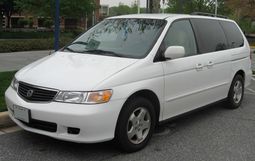
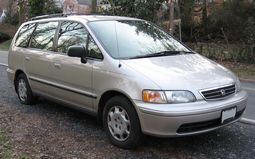
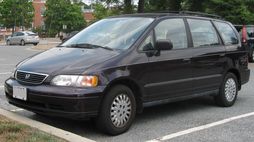
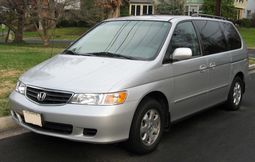
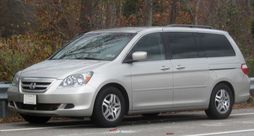
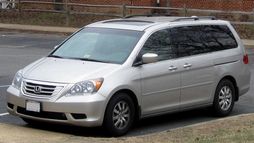


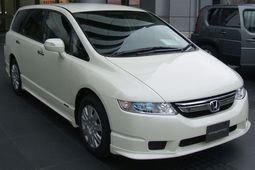
|